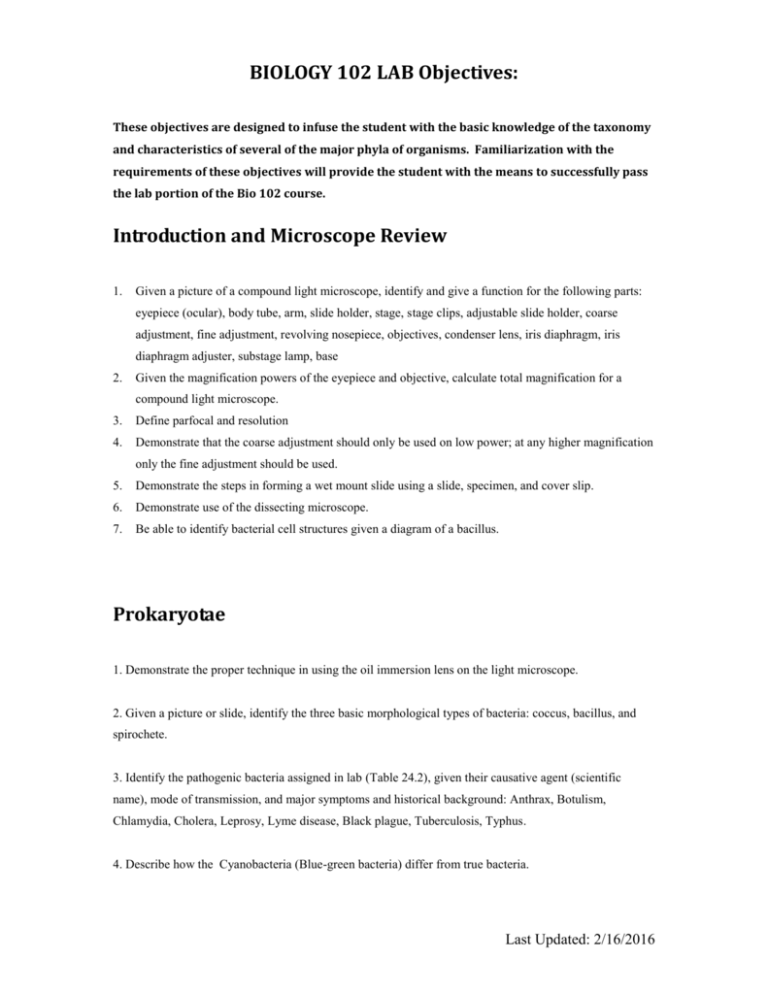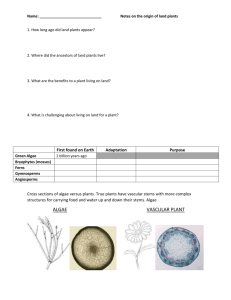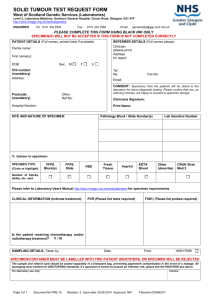BIO 102 Lab Objectives
advertisement

BIOLOGY 102 LAB Objectives: These objectives are designed to infuse the student with the basic knowledge of the taxonomy and characteristics of several of the major phyla of organisms. Familiarization with the requirements of these objectives will provide the student with the means to successfully pass the lab portion of the Bio 102 course. Introduction and Microscope Review 1. Given a picture of a compound light microscope, identify and give a function for the following parts: eyepiece (ocular), body tube, arm, slide holder, stage, stage clips, adjustable slide holder, coarse adjustment, fine adjustment, revolving nosepiece, objectives, condenser lens, iris diaphragm, iris diaphragm adjuster, substage lamp, base 2. Given the magnification powers of the eyepiece and objective, calculate total magnification for a compound light microscope. 3. Define parfocal and resolution 4. Demonstrate that the coarse adjustment should only be used on low power; at any higher magnification only the fine adjustment should be used. 5. Demonstrate the steps in forming a wet mount slide using a slide, specimen, and cover slip. 6. Demonstrate use of the dissecting microscope. 7. Be able to identify bacterial cell structures given a diagram of a bacillus. Prokaryotae 1. Demonstrate the proper technique in using the oil immersion lens on the light microscope. 2. Given a picture or slide, identify the three basic morphological types of bacteria: coccus, bacillus, and spirochete. 3. Identify the pathogenic bacteria assigned in lab (Table 24.2), given their causative agent (scientific name), mode of transmission, and major symptoms and historical background: Anthrax, Botulism, Chlamydia, Cholera, Leprosy, Lyme disease, Black plague, Tuberculosis, Typhus. 4. Describe how the Cyanobacteria (Blue-green bacteria) differ from true bacteria. Last Updated: 2/16/2016 BIOLOGY 102 LAB Objectives: 5. Identify pictures or slides of Oscillatoria, Gleocapsa, and Nostoc as examples of cyanobacteria. 6. Describe the major steps in conducting a Gram stain. Protozoa 1. Describe the three major groups of organisms that comprise the Kingdom Protista: Protozoa (animal-like protists); True Algae (plant-like protists), and Fungi-like protists (slime molds and water molds). 2. Given a picture or slide of amoeba (Phylum Rhizopoda), identify: pseudopodia, nucleus, contractile vacuole, food vacuole, phagocytosis 3. Identify Trypanosoma (Phylum Sporozoa, class Apicomplexa, from a slide or picture. 4. Describe the life cycle of Trypanosoma, the causative agent of sleeping sickness including in your discussion the role of tsetse flies, humans, and cows. 5. Given a picture or slide of Paramecium (Phylum Ciliophora) identify and give a function for the following structures: cilia, micronucleus, macronucleus, food gullet, contractile vacuole, food vacuole, conjugation 6. Given a picture or slide, identify Plasmodium, the causative agent for malaria. Describe the life cycle of Plasmodium including the role of mosquito and humans. 7. Given a picture of Physarum, identify it as a slime mold. Define amoeboid gametes, flagellated gametes, spores. Algae 1. Define eukaryotic, autotrophic, heterotrophic, colonial. 2. Name the two most important biochemical considerations in classifying algae: ( Plant pigments and form of starch are the two major biochemical considerations in classifying algae). Last Updated: 2/16/2016 BIOLOGY 102 LAB Objectives: 3. Identify Chlamydomonas as a unicellular green algae. Define asexual, zygospore, haploid, diploid, gamete 4. Identify Spirogyra as a filamentous green algae. Define conjugation tube, nucleus, chloroplast 5. Identify Volvox as a colonial green algae. Define daughter cells. 6. Identify Sargassum and Fucus as examples of brown algae (Phylum Phaeophyta). 7. Define the parts of a seaweed: holdfast, blade, stipe, bladder. 8. Identify Polysiphonia as an example of red algae (Phylum Rhodophyta) 9. Define “agar” as a product of red algae. 10. Recognize diatoms given a picture or slide. Define: diatomaceous earth, silicon shell 11. Given a picture or slide of Euglena, identify and define eyespot, flagellum, chloroplast, mitochondrion, contractile vacuole Fungi 1. Define: hypha, mycelium, extracellular digestion, saprophyte, parasite, coenocyte, chitin, budding, fragmentation (asexual reproduction). 2. Given a picture or slide, identify Rhizopus (black bread mold). Define: sporangium, stolon, rhizoid, Zygosporangium (sexual reproduction). 3. Given a picture or slide, identify Penicillium and Aspergillis. Define conidia, antibiotic 4. Describe how the “sac fungi” and “club fungi” get their name. 5. Given a slide or picture, identify Saccharomyces (yeast). 6. Given a picture of a mushroom, label and give a function for: cap, gills, Pileus, basidium. Last Updated: 2/16/2016 BIOLOGY 102 LAB Objectives: 7. Describe at least four useful benefits derived from fungi. 8. Define symbiosis and mutualism. 9. Describe the two organism that comprise a lichen. 10. Given a picture, identify Crustose, foliose, and Fruticose lichens. Mosses, Liverworts and Hornworts 1. List the four major groups of plants (Bryophytes (mosses), Ferns, Gymnosperms (conifers), and Angiosperms (flowering plants) and compare these as: a. vascular or non-vascular, b. spore or seed producers, c. cones, or fruits and flowers. 2. Identify mosses, liverworts, and hornworts from pictures or preserved specimens. 3. identify at least two characteristics that mosses, liverworts, and hornworts have in common: non-vascular bodies and spore-production 4. Given a picture or slide of a moss (Polytrichum) identify: sporophyte, gametophyte, rhizoids, antheridia, archegonia, and Thallus. Ferns, Horsetails, Club mosses. 1. Given a picture or specimen identify: fern, horsetail (Equisetum), whisk fern (Psilotum), club moss (Lycopodium) 2. Identify the following, given a picture of the life cycle of a fern: gametophyte, sporophyte, antheridia, archegonia, egg, Last Updated: 2/16/2016 BIOLOGY 102 LAB Objectives: sperm, zygote, frond, rhizome, sporangium, haploid (n), diploid (2n), sorus Gymnosperms 1. Given a specimen or picture, identify cycad, gingko, and various conifers (pine, spruce, fir). 2. Define: microspores, megaspores, cone (strobilus), pollen-bearing (staminate) cones, seed-bearing (ovulate cones), Angiosperms 1. Given a specimen or picture, identify cycad, ginko, and various conifers (pine, spruce, fir). Be able to place these organisms in their particular classes within the Gymnosperms. 2. Identify the following structures associated with a bean seed: seed coat, cotyledon, embryo Roots, stems, and leaves 1. Given a picture or a prepared slide of a longitudinal section of a dicot root, identify and give a function for: root cap, apical meristem (zone of ell division), zone of elongation, zone of maturation, root hairs 2. Given a picture or a prepared slide cross-section of a dicot root system, identify and give a function for: epidermis, cortex, pericycle, endodermis, xylem, phloem. 3. Given a picture or a prepared slide cross-section of a dicot stem such as Helianthus (sunflower) identify and give a function for: epidermis, xylem, phloem, pith 4. Given a picture or a prepared slide of a monocot stem (Zea mays, corn or other monocot), identify epidermis, vascular bundles, ground tissue. Give the main difference between monocot and dicot stems. Last Updated: 2/16/2016 BIOLOGY 102 LAB Objectives: 5. Given a picture or a prepared slide, cross-section of a Ligustrum (privet hedge) or other leaf, identify and give a function for: cuticle, upper epidermis, palisade mesophyll, spongy mesophyll, vascular bundle (vein), stoma, guard cells. Phyla Porifera (Sponges) and Cnidaria (Coelenterates) 1. Define sessile, filter feeder, spicule, sponging 2. Given a picture of a sponge identify and give a function for: choanocyte (collar cell), amoebocyte, osculum, spongocoel, spicule 3. Give an example of the animals in each of the following classes: Class Hydrozoa (hydras), Class Scyphozoa (jellyfish), Class Anthozoa (anemones, corals) 4. Define radial symmetry, ectodermis, endodermis, medusa, polyp, mesoglea, gastrovascular cavity, cnidocytes, nematocysts, 5. Given a picture of Hydra, label and identify: tentacles, gastrovascular cavity, mouth 6. Given a picture of the jellyfish life cycle label: polyp, medusa 7. Explain the advantage of having a polyp and medusa stage 8. Given a picture or specimen, identify corals, sea anemone Phyla Platyhelminthes and Nematoda 1. Give an example of an organism belonging to each of the following Platyhelminthes classes: Turbellaria, Trematoda, and Cestoda. 2. Define the terms: acoelomate, hermaphrodite, endoderm, mesoderm, ectoderm 3. Given a picture or specimen of Dugesia (the planarian) identify: eyespot, gastrovascular cavity, pharynx. 4. Given a picture or slide of Fasciola (sheep liver fluke) identify: oral sucker, ventral sucker, uterus, testes. 5. Describe the major stages in the life cycle of Fasciola Last Updated: 2/16/2016 BIOLOGY 102 LAB Objectives: 6. Describe he major stages in the life cycle of Schistosoma (blood fluke). 7. Given a specimen or prepared slide of Taenia (beef tapeworm) identify and define: scolex, proglottid, uterus, testes, genital pore, vagina. 8. Identify the intermediate host and primary host in the life cycle of Taenia. Identify how a human would contract a tapeworm. 9. Describe the life cycle of Ascaris, the human roundworm including how humans would contract this parasite. 10. Describe the life cycles of the following roundworms: Trichinella (causative agent of trichinosis), Enterobus (pinworms) and Necator (hookworm including how each would be contracted. Phyla Mollusca and Annelida 1. Define coelomate, protostome, deuterostome, endoderm, mesoderm, ectoderm, open circulatory systems. 2. Given a picture or specimen identify and define the following structures: visceral mass, muscular foot, mantle, calcium-based shell, radula. 3. Describe a specific mollusk that is a “filter-feeder”, one that is a predator/carnivore, and one that is a herbivore. 4. Give an example of a mollusk in each of the following classes: Class Polyplacophora, Class Bivalvia, Class Gastropoda, Class Cephalopoda. 5. Given a preserved specimen or picture identify and give a function for the following structures associated with a clam: umbo, hinge, anterior and posterior adductor muscles, heart, mantle, gills, foot, labial palp, anus, excurrent siphon, incurrent siphon, stomach, digestive gland. See Figure 38.8. pertaining to the Phylum Nematoda: pseudocoelomate, cuticle. Last Updated: 2/16/2016 BIOLOGY 102 LAB Objectives: 6. Given a picture or actual specimen identify a snail, slug, clam, oyster, squid, octopus, Nautilus 7. Give an example of an Annelid in each of the following classes: Polychaeta, Oligochaeta, Hirudinea 8. Identify and give a function for the following external features of an earthworm: prostomium, mouth, setae, seminal receptacles, clitellum. 9. Identify and give a function for the following internal structures associated with an earthworm: mouth, brain, pharynx, hearts, esophagus, male gonads (testes), female gonads (ovaries), dorsal and ventral blood vessel, crop, gizzard, intestine, ventral nerve cord Objectives Phylum Arthropoda 1. Describe the two most distinctive features of the Phylum Arthropoda: jointed appendages and a chitinous exoskeleton. 2. Give an example of an animal belonging to the following arthropod classes: Class merostomata, Class insecta, Class Crustacea, Class Arachnida, Class Chilopoda, Class Diplopoda. 3. On a picture or specimen of Limulus (horseshoe crab) identify: cephalothorax, abdomen, carapace, chilaria, book gills. 4. Identify pictures or specimens of spiders, mites, and ticks (Class arachnida). 5. Given a picture or specimen of crayfish identify and give a function for the following external structures of the crayfish: (dorsal view) antenna, antennules, cheliped, rostrum, eye, walking legs, carapace, abdomen, uropod, telson (ventral view) mouth, maxilliped, swimmerets, anus (See Figure 39.7) Determine whether a crayfish is male or female (examine the swimmerets). 6. Given a picture or specimen of crayfish dissection identify and give a function for the following internal structures of the crayfish: brain, ventral nerve cord, mouth stomach, intestine, antennal (green) gland, heart, pericardium, testes or ovaries, anus, digestive glands, gills. 7. Identify Class Chilopoda (centipedes) and Class Diplopoda (millipedes). Last Updated: 2/16/2016 BIOLOGY 102 LAB Objectives: 8. Given a specimen or picture of a grasshopper identify and describe the function for: head, thorax, abdomen, antenna, compound eye, ocelli, tympanum, spiracles, mandibles, maxilla, labrum, labium. 9. Given a picture or a specimen of grasshopper dissection identify and describe a function for: brain, ventral nerve cord, ganglia, mouth, crop, stomach, intestine, gastric caeca, Malpighian tubules, ovary (if female), ovipositor (if female). Phyla Echinodermata, Hemichordata, and Chordata 1. Define the terms: Protostomes, Deuterostomes, ossicles, water vascular system, tube feet, radial symmetry. 2. Describe three characteristics that distinguish the Phylum Echinodermata. 3. Give an example of an animal in each of the following Echinoderm classes: Class Asteroidea, Class Echinoidea, Class Holothuroidea, Class Crinoidea, Class Ophiuroidea. 4. Given a picture or specimen of sea star (Class asteroidean) identify and give a function for: arm, madreporite, anus, spines, central disk, tube feet, ambulacral groove, and mouth. 5. Given a picture or a specimen of sea star (Class asteroidean) identify and describe a function for: digestive gland, gonad, tube feet, radial canal, ring canal, cardiac stomach, pyloric stomach. 6. Phylum Chordata. Describe 4 characteristics that all chordates have in common. 7. Name and describe the basic characteristics of the two invertebrate chordates: tunicates (sea squirts) and Amphioxus (lancelet) 8. Give an example of an animal in each of the following Chordate classes: Agnatha, Chondrichthyes, Osteichthyes, Amphibia, Reptilia, Aves, Mammalia. 9. Given a picture or specimen of the Class Osteichthyes (bony fish - perch): identify and describe a function for: dorsal fin, caudal fin, pelvic fin, pectoral fin, lateral line, operculum, nostrils, gills. Internal anatomy: stomach, liver, pancreas, intestine, air bladder, heart, gonad, spleen, gills. 10. Identify and describe a function for the following structures associated with a frog (Class amphibian): nostrils, forearm, leg, tympanum, mouth: vomerine teeth, internal nares, esophagus, pharynx, Eustachian tube, glottis. Internal anatomy: liver, gall bladder, stomach, small intestine, large intestine, pancreas, heart, spleen, testes (or ovaries), kidneys, fat bodies, urinary bladder. Last Updated: 2/16/2016 BIOLOGY 102 LAB Objectives: 11. Describe the structure of an amniotic egg and give a function for: amnion, chorion, allantois, yolk sac. Indicate the importance of the amniotic egg to animal evolution. Tissues 1. Name the four basic types of human tissue. 2. Identify and give a function for: Simple epithelium, stratified epithelium, epithelium shapes (squamous, cuboidal, and columnar). 3. Identify and give a function for: loose connective tissue, dense connective tissue (ligaments and tendons), adipose tissue, blood, elastin, reticulin, cartilage and bone. 4. Compare the three muscle types (skeletal, smooth, and cardiac) based on whether they are: Striated non-striated, voluntary, involuntary and know their location and function in the body. 5. Given a slide or picture of a nerve cell identify and give a function for: dendrites, axon, nerve cell body, nucleus, node of Ranvier, myelin sheath Skeletal system - Objectives 1. Define axial and appendicular skeleton. 2. Identify the bones that constitute the “pectoral girdle” (clavicle and scapula) and the pelvic girdle (ilium, ischium, and pubis) 3. State the function of the pelvic and the pectoral girdles. 4. Given a diagram or actual skeleton identify the following bones: arm (phalanges, metacarpals, carpals, radius, ulna, humerus) leg (phalanges, metatarsals, tarsals, tibia, fibula, femur, skull (mandible, maxilla, occipital bone, foramen magnum), sternum, manubrium, xiphoid process, ribs, vertebra (cervical, thoracic, lumbar, sacral, coccygeal) 5. State the difference in a tendon and a ligament 6. Identify the bones that form the ankle, the chest, and your neck Breathing - Objectives 1. Identify the following structures associated with the respiratory system: nostril, nasal cavity, pharynx, epiglottis, larynx, trachea, bronchi, bronchioles, lung, alveolus, diaphragm Last Updated: 2/16/2016 BIOLOGY 102 LAB Objectives: 2. Pertaining to lung capacity define: tidal volume, inspiratory reserve volume, expiratory reserve, residual volume, vital capacity 3. Demonstrate how to use a spirometer to measure lung capacity. Circulation and Blood Pressure 1. From a picture or a model, be able to identify the internal anatomical structures of the heart. 2. From a picture or a model, be able to identify major arteries and veins. 3. Learn the pathway of the blood. 4. Know what blood pressure is and how it is measured. Be able to explain systole and diastole. 5. Complete the analysis of “Your Risk of Cardiovascular Disease” in the lab book (page 506). Know what your risk factor is and learn the point ranges for Low, Medium, and High risk. Sensory Systems – Objectives 1. Know the basic anatomy (internal and external) of the eye and the ear. 2. Know the functions and be able to identify the following structures of the vertebrate eye, given a picture or a model: cornea, cones, rods, retina, pupil, iris, lens, and optic nerve. 3. Know the definitions/characteristics of : the blind spot, near point, afterimages, visual acuity, astigmatism, and peripheral vision. 4. Know the functions of, and given a picture or a model be able to identify the following structures of the human ear,: pinna, auditory canal, Eustachian tube, malleus, stapes, incus, cochlea, and tympanic membrane. 5. Know what common instruments you used to test for hearing loss in the lab. Fetal Pig (Mammalian Anatomy) – Objectives 1. Be able to identify the following internal structures of the fetal pig: heart, lungs, liver, stomach, pancreas, spleen, thymus, and thyroid. 2. Be able to identify the following external structures of the fetal pig: umbilicus, vulva, penis, pinna, nares. Last Updated: 2/16/2016





